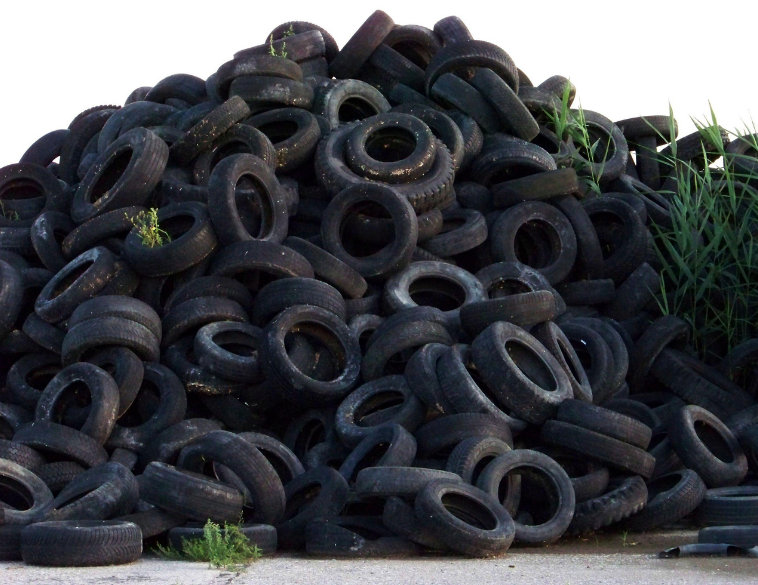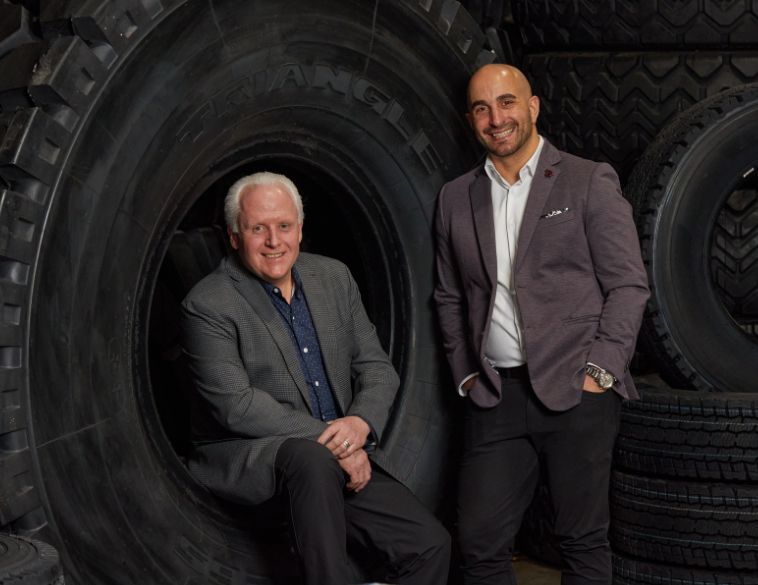Finding the best options for disposing of and recycling scrap tires
Traditionally, one of the biggest issues facing the automotive and transportation ecosystem has been what to do with scrap tires. When they are no longer suitable for use on vehicles due to wear or irreparable damage, used tires can become a huge ecological problem. There have been, however, major strides in developing sustainable practices for both the disposal and recycling of scrap tires. Yet some of these are not always evident, plus, with new developments in technology and recycling practices continuing to emerge, sustainable tire recycling continues to be a moving target.
In an exclusive interview with Autosphere, Dr. Ben Chouchaoui, a rubber Product Development Engineer and Specialist from Windsor Industrial Development Laboratory in Windsor, Ont., discusses some of the more recent trends in scrap tire disposal and recycling as well as some of the opportunities new practices are bringing to the industry.

Autosphere: When we look at the disposing of scrap tires today, what are some of the things to consider in ensuring it is done responsibly and sustainably?
Ben Chouchaoui: As a rule of thumb, every person on the planet scraps a tire every year. In Canada and the U.S., approximately 400 million tires are disposed of annually. In the past, old tires typically went to local landfills or were burnt–neither of which were good environmental strategies. Burning old rubber tires releases dangerous toxins and pollutes the atmosphere. And since old tires are not biodegradable, they take up more and more space in landfills over time, as well as becoming breeding grounds for rats and mosquitoes.
Before the states and provinces began to pass scrap tire laws in the 1980s, there were approximately 2 to 3 billion tires stockpiled in landfills across North America. Today, as many as 90% of those stockpiled tires have been recycled successfully. Old tires have gone from an environmental nuisance to a recycling success story over the last 25 years. According to the Environmental Protection Agency, about 85% of (or roughly 340 million) scrap tires now get recycled each year.
When buying a new tire today, the dealer usually recoups the old tire for recycling. Of course, some people might use their old tires for a new purpose, such as turning them into tire swings or garden planters. Alternatively, local community recycling centres constitute drop-offs for old tires to be recycled. Public awareness and educating younger generations to properly dispose of used tires is important so that they get directed to commercial reprocessing plants to be treated and broken down into materials that can ultimately be reused in making up new products.
Public awareness and educating younger generations to properly dispose of used tires is important so that they get directed to commercial reprocessing plants.
AS: There are different views on which organizations or entities should be responsible when it comes to overseeing the recycling of scrap tires. What are your thoughts on that?
BC: Scrapped tire recycling should be industry-driven with some government support—two ingredients that vary widely throughout the world. Not long ago, tires were burned as an alternative fuel source to generate power (an undertaking still practiced in emerging economies).
Currently, more than 110 different products come from recycled tires in North America. Recycled tire rubber is used to make rubberized asphalt, which in turn is used to resurface roads. It also finds its way into all sorts of other products, including rubber-encased railroad ties, rubber composite decks, sports courts, running tracks, playground surfaces, public walkways, garden mulch, construction backfill, erosion control barriers, and even moulded automobile parts, such as engine drive belts and floor mats.
New products derived from waste tires generate more economic activity than combustion or other low multiplier production while reducing the waste stream without generating excessive pollution and emissions as a result of recycling operations. There are tire recycling business opportunities around the world. The process is sequential, evolving from TDF (tire-derived fuel) to mulch (natural or coloured), to crumbs and fine powder. Steel and fibres from processed tires are recycled, and a current state-of-the-art process is to devulcanize the rubber with which to make new products (mixed to given ratios with non-recycled rubber, depending on the stringencies of the applications).
AS: Do you feel that having similar practices for recycling scrap tires in different regions of the world is practical and if so, how do you think it could be implemented?
BC: The benefit of similar practices for recycling scrap tires in different regions of the world is uniformity and a standard of quality in the end products. If the various components of tires (steel, nylon, and rubber mix (natural and synthetic rubber and silica)) can be recovered, then the quality of the output can be checked through testing coupons as per ASTM (the American Society of Testing and Materials).
Pyrolysis, a technique that heats whole or shredded tires in a reactor vessel containing an oxygen-free atmosphere, has been introduced in the U.S. Rubber is softened and rubber polymers are broken down into smaller molecules that vaporize and then exit from the reactor. The minerals in the tire, about 40% by weight, are removed as solid ashes. When performed properly, tire pyrolysis is clean and produces little emissions or waste; however, concerns about air pollution due to incomplete combustion (as is the case with tire fires) have been documented.
The other emerging alternative is using chemistry to break down molecular bonds. The devulcanized rubber is then mixed with non-recycled rubber to mould new parts.
AS: When a typical passenger vehicle tire is shredded and recycled, how much of it can be practically reused?
BC: Whole tires can be used in gardens and playgrounds, around boat docks, as anti-collision stoppers, but these make for very limited applications. Stamping and cutting tires are used in emerging countries for some apparel products such as sandals. Shredded tires can also be used in civil engineering applications such as sub-grade fill and embankments, back-fill for walls and bridge abutments, sub-grade insulation for roads, landfill projects, and septic system drain fields. Artificial reefs are built using tires that are bonded together in groups, though there is some controversy on how effective tires are as an artificial reef system.
An example of that is the Osborne Reef Project which became an environmental nightmare that cost millions of dollars to rectify. Using granulators, steel and nylon can be removed from rubber nuggets with further size reductions. Depending on the cleanness of the breakdown, steel and nylon can be recycled 100%. Crumb rubber can be used for many purposes, such as bedding for animals, mulch, landscapes and underlays, etc.
Further reductions in size result in rubber powder that can be used to surface sport tracks and ultimately as fillers (replacing carbon black for example). Post-recycling applications should be studied–for example, what happens when using rubber shreds instead of gravel for resurfacing a road (collecting tires is much easier than rubber nuggets that can be further spread with rains and winds)? An ultimate solution is to devulcanize the rubber so it can be re-moulded, even if mixed with new non-recycled rubber.
AS: What are your thoughts on recovering rubber compounds and other scrap materials to make new tires?
BC: Pneumatic tires are manufactured in about 450 tire factories around the world. Tire production starts with bulk raw materials such as rubber, carbon black, and chemicals, and produces numerous specialized components that are assembled and cured. Many kinds of rubber are used, the most common being styrene-butadiene copolymer (SBR).
In 2019, $258 billion worth of tires were sold worldwide. Over three billion tires are manufactured annually, making the tire industry a major consumer of rubber. It, therefore, makes sense to use recycled rubber in making new tires even if tires are highly critical components of vehicles. Essentially, two options are possible. First, using fine powder rubber from recycling tires as fillers in compounds for new tires, and second, devulcanizing crumb rubber and mixing it with non-recycled rubber for manufacturing tires.
AS: Given the shortage of natural rubber and global supply chain issues regarding tires, do you think there can be ways where innovation through tire recycling can help solve some of these problems?
BC: Absolutely, every ounce of recycled material reduces the need for the equivalent of new material. The paradigm shift is in devulcanizing the ground rubber from recycling tires.
AS: Is there anything else you’d like to mention?
BC: Interestingly, I am studying a European technology to devulcanize crumb rubber and recently connected with three American tire recyclers (from Michigan, Illinois, and Colorado), as well as a rubber moulder in Ontario. The project consists of devulcanizing rubber from different sources and processes, and intends to make parts for the Mining Industry. It takes into account various ratios of “devulcanized rubber to non-recycled rubber” and then runs comparative validation tests against similar parts made of non-recycled rubber.



